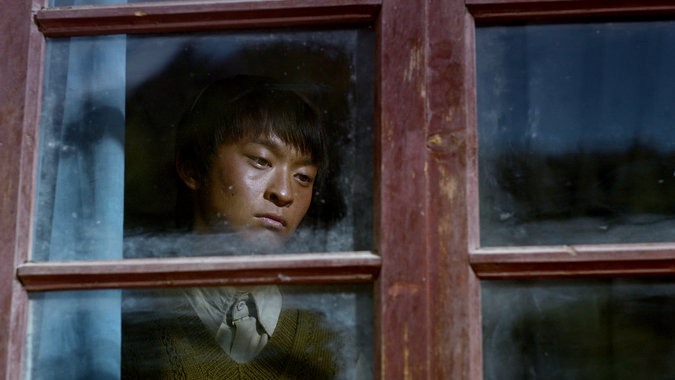
Jinpa as Tabei, left, and Choenyi Tsering as Chung in “Soul on a String,” directed by Zhang Yang and based on a story by the prominent Tibetan writer Tashi Dawa. The actors and the dialogue in the film are Tibetan. Credit Zhang Shengbin
SHANGHAI — As the 19th Shanghai International Film Festival gets underway Saturday, much of the focus among participants is on the 14 contenders for the Golden Goblet, the top prize at the event that runs through June 19. From the Philippines to Denmark, Iran to Japan, the films’ origins cover the globe.
But among them, one region stands out. The rugged terrain of China’s Tibetan areas forms the backdrop for two of the country’s three competitors: “De Lan,” by the director Liu Jie, and “Soul on a String,” by Zhang Yang.
Together, the films highlight a shift in the cinematic depiction of China’s ethnic minorities, especially of Tibetans.
“Before, Tibet was usually portrayed in Chinese films in several ways,” said Wu Jueren, who oversees the Chinese-language programming for the festival. “There were the socialist propaganda films, that were meant to show ethnic harmony and national unity, and the commercial films, which often portrayed Tibet as a kind of mythical healing land where people would go to escape.”
Although such films are still being made, the scope of films about Tibet is expanding as Chinese filmmakers seek new ways to approach what can be a delicate and highly politicized subject.
For years, China’s Communist Party has accused the exiled Dalai Lama, the widely revered Tibetan spiritual leader, of supporting Tibetan independence. Tensions have grown since a 2008 Tibetan rebellion, which prompted a government-led security crackdown in the autonomous region as well as a wave of self-immolations by Tibetans in protest.
Still, “filmmakers are starting to more accurately capture the essence of life in Tibet,” said Pema Tseden, a Tibetan filmmaker and a member of the jury for this year’s Golden Goblet. “They are starting to let go of the old stereotypes.”
The demystification of Tibet in China’s films has been driven in part by the steady rise of tourism to the region in recent decades. Although there are still restrictions on travel to Tibet, droves of Chinese and non-Chinese visitors have been able to see firsthand a part of the world previously accessible to them only through images and stories.
More important, some experts say, is the emergence in the past 10 years of a contingent of Tibetan filmmakers. With films like Mr. Tseden’s “Tharlo” (2015) and Sonthar Gyal’s “River” (2015), the “new Tibetan wave” of directors has presented audiences with an unvarnished view of life in modern Tibet, stripped of fantasy and exoticism.
“These young Tibetan filmmakers are trying to make us look very hard without giving us answers,” said Robert Barnett, director of the modern Tibet studies program at Columbia University. “Many of their films provide an uncompromising view of difficulty in modern society. They’re not deliberately provocative, but they also don’t offer us comfortable resolutions.”
Many of the films deal with the impact of modernization on Tibetan cultural traditions. Some Chinese directors who belong to the country’s ethnic majority, the Han, say these Tibetan productions have helped them better understand their relative position as cultural outsiders.
“Films made by Tibetans about themselves can serve as a kind of reference point for non-Tibetan filmmakers,” said Mr. Zhang, whose previous films have included “Shower” (2000) and “Getting Home” (2007). “They push us to break away from the traditional movie narrative that takes Tibetan culture as a novelty.”
To prepare for “Soul on a String,” Mr. Zhang spent several months in 2013 living in Tibet. Some of his experience was captured in last year’s “Paths of the Soul,” a part-documentary, part-fiction feature by the director about a group of Tibetans on a 1,200-mile pilgrimage through Lhasa, the regional capital.
“It was important to me to first understand Tibetans — what their everyday life was like and their religion — before I felt ready to make ‘Soul on a String,’ ” he said.
The new film, based on a story by the prominent Tibetan writer Tashi Dawa, draws on Tibetan folk traditions and magical realist elements to relate the adventures of a man named Tabei (the Tibetan actor Jinpa) who is brought back to life by a living Buddha after being killed by lightning. The film follows him as he pursues a mission to bring a Dzi bead, or protective amulet, to a holy land. All of the actors in the film are Tibetan and speak Tibetan.
Until now, some critics say, not many non-Tibetan filmmakers have succeeded in moving past a very stylized depiction of Tibetans as a people apart.
“Besides the state-supported propaganda films, there are a few films down the middle that show what happens when presumably well-meaning ethnic Han directors create portraits of a Tibetan ‘other,’ ” said Shelly Kraicer, a film critic in Toronto and a scholar of Chinese cinema.
What happens? “At the end of the day,” he said, “everybody is still using and exploiting images of Tibet.”
Films about ethnic minorities, and in particular films about Tibet, are subject to special scrutiny in China to make sure they comply with government restrictions on discussions of the region’s history and religion.
All films about Tibetan areas are sent for approval to the Tibet committee of the United Front Work Department under the Communist Party’s Central Committee — not just the state media regulator, as is the case with most films.
“You have to communicate with the censors a lot,” said Mr. Liu, director of “De Lan.” “Much more than with most films.”
Mr. Liu’s film, made in the Tibetan areas of northern Yunnan Province and set in the 1980s, concerns a young ethnic Han named Xiao Wang (Dong Zijian) who travels to Tibetan villages to make loans and collect payments. In one of the villages, he falls in love with a local woman, De Lan (De Ji).
“It’s a very sensitive topic,” said Mr. Liu, who recalled the divided response after he showed the film to people within the industry. “One group of people said, ‘No, you can’t do that; you showed the poverty of Tibetans.’ Then another group of people said, ‘You are showing Han people giving money to the Tibetan people.’ ”
To get films past the censors, some filmmakers say, they deliberately focus on narrow depictions of everyday life while avoiding larger narratives concerning religion or history.
“Of course, the films will still touch on religion and history,” Mr. Tseden said. “It’s not possible to exclude them altogether, since they are so intertwined with daily life.”
Despite the censorship and restrictions, many filmmakers are optimistic. Tibetans are increasingly interested in film, they say, and local directors still have a range of relatively apolitical topics to explore, including the effects of modernization and other internal issues.
When it comes to non-Tibetan filmmakers, however, many observers are more pessimistic. Even as some non-Tibetan directors seek out new Tibetan stories to tell, they say, the evolution of Tibetan films will remain stunted unless the elephant in the room — government censorship — is addressed.
“Non-Tibetans, whether Chinese or Western, have to confront their own history of colonialism if they are to make a serious film about a place or people colonized or semi-colonized by their society,” Mr. Barnett of Columbia University said. “Otherwise, the result is always a kind of condescending exoticism, even if sympathetic.”





 Print
Print Email
Email